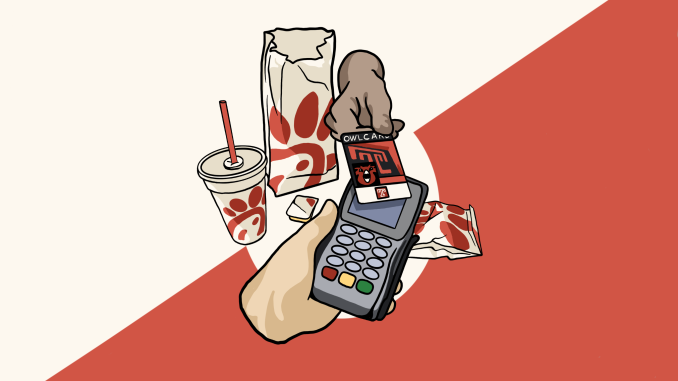
On Feb. 6, Temple University Culinary Services increased prices at on-campus dining restaurants like Chick-Fil-A, Which Wich and Twisted Taco, in compliance with national brand pricing, according to Temple Dining signage that was posted outside the Chick-Fil-A in the Howard Gittis Student Center.
As of last semester, Temple Dining meal equivalency swipes were worth $9.25 for lunch and dinner and $6.71 for breakfast hours. However, the recent price hikes have caused the cost of many of students’ favorite meals to move above the equivalency threshold. For example, the Chick-Fil-A sandwich combo was previously $9.25 until the price rose to $9.45.
Some of the meals that were originally covered under one meal swipe will now require two swipes or a swipe and the difference in Diamond Dollars, the university’s monetary currency. When students use two swipes, they waste the second on just one meal.
Temple Dining must raise the equivalency value to $9.50 for lunch and dinner to allow students to use one meal swipe for a standard meal. An increase to $9.50 is enough to offset the recent winter price increase and would eliminate students’ need to use additional Diamond Dollars or waste a swipe on one meal. With rising inflation, students should be able to maximize their meal plan and get the best value for their money.
Temple Dining has increased the meal equivalency threshold before. In August 2021, they increased the meal equivalency rate from $8.69 during lunch and dinner to $9.25, a 56-cent increase.
Temple Dining did not respond to The Temple News’ request for comment about previous instances of increasing the meal equivalency rate.
Oftentimes, some students will purchase a meal without realizing the cost, causing them to use and waste more than one swipe and nearly eight dollars worth of food.
“I’ve been using it since the semester started and I guess it’s been taking two meals from me,” said Liv Dedman, a freshman social work major.
New students living in Temple-affiliated housing are required to purchase a meal plan. Meal plans range from $2,024 to $2,355 per semester and deals for returning students and those living off-campus range from $568 to $1,073.
All meal plans, except the unlimited plan, grant off-campus and on-campus students $50 worth of Diamond Dollars each semester. Students also can add Diamond Dollars to their accounts at any time. The funds can be used at any Temple-affiliated restaurant, including those in the Student Center and at the Morgan Hall food court.
Jaden Henninger, a junior business management major, has opted to use Diamond Dollars to cover the extra cost of his Chick-Fil-A following the price increase.
“I get it four times a week,” Henninger said. “Personally, I use Diamond Dollars because if you use a whole meal swipe, you’re wasting eight dollars almost.”
With students spending thousands of dollars each semester on meal plans, they should not be forced to spend additional money due to an incremental rise in the cost of one meal equivalency.
Students have already been burdened by the effects of higher food prices, so it’s unfair for them to pay additional money or sacrifice a meal swipe to cover the difference. In January, the inflation rate for food hit 10 percent, according to the Bureau of Labor Statistics.
“It doesn’t make sense,” Dedman said. “I’m losing my meal swipes super fast. I feel like I can’t keep getting food because Chick-Fil-A is taking two meal swipes instead of one. Now I’ve used two meals by 11 o’clock and I only have 15 for the week. My roommate only has 10.”
Temple Dining understands that students might be upset about the rise in costs, but they must raise the prices in compliance with national brand pricing, they wrote in a message to The Temple News.
“We can confirm that any price increases taken are in direct alignment with national brand pricing,” they wrote. “We’re fortunate to have almost exclusively National and regional brands on campus. In light of that, we carefully follow brand guidelines for this sort of thing.”
Despite not having the option to adjust the cost of national products, Temple Dining can adjust the equivalency rate in ordinance to the cost.
Adjusting the cost of meal equivalencies will help students, who are already paying thousands of dollars on tuition, housing and meal plans, afford to eat on campus. An upcharge for a sandwich shouldn’t force students to spend more money than they are already spending on a meal plan.
Temple must accommodate their meal swipe equivalency rate to match the rising cost of basic meals so that students can afford to eat on campus.



Be the first to comment